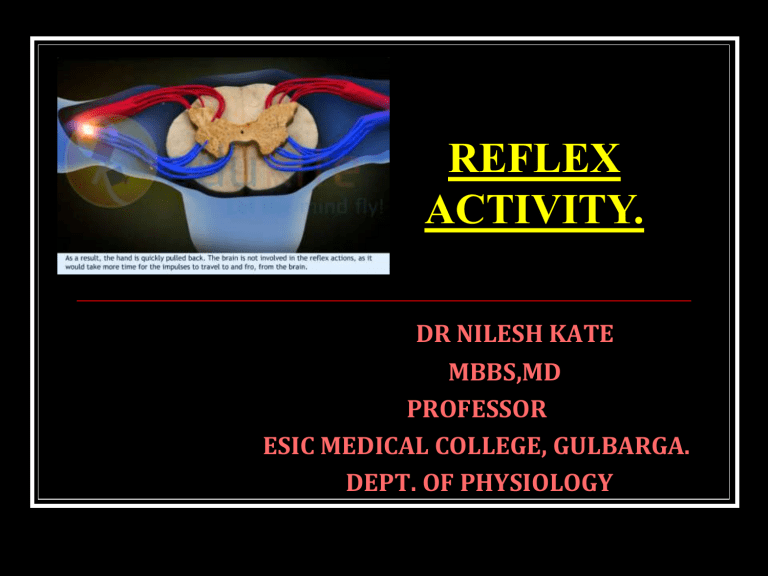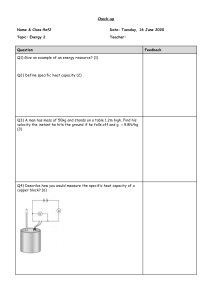
REFLEX ACTIVITY. DR NILESH KATE MBBS,MD PROFESSOR ESIC MEDICAL COLLEGE, GULBARGA. DEPT. OF PHYSIOLOGY OBJECTIVES. Skeletal muscle :- the effector organ Motor unit Muscle sensors Muscle tone Reflex activity General considerations Spinal cord reflexes Clinical reflexes Skeletal muscle :- The Effector organ Motor unit Muscle sensors Muscle spindle Golgi tendon organ Pacinian corpuscle Free nerve endings Muscle tone Motor unit Single motor neuron & the muscle fibre that it innervates. Tuesday, February 4, 2020 Muscle sensors Proprioceptors present in muscles, tendons, joints, ligaments, fasciae. Gives information about change in position of different parts of body in space. Tuesday, February 4, 2020 Muscle Spindle Stretch receptors in skeletal muscles Resposnsible for proprioceptive mechanism. Muscles for precision movements contains more muscle spindles than postural muscles. Tuesday, February 4, 2020 Structure Contains 3-10 small intra-fusal fibres Encapsulated in a capsule containing fluid. Present in between & parallel to extra-fusal fibers & their ends attached to endomysium of extra-fusal fibres. Tuesday, February 4, 2020 Intra-fusal muscle fibre Contains central noncontractile portion without actin, myosin. 2 ends called striated poles which are contractile. Central part is sensory portion. Tuesday, February 4, 2020 Types. Nuclear bag fibres 2-5 30 µm in diameter Length – 7 mm Nuclei present in central bag like portion Nuclear chain fibres 6-10 15 µm in diameter Length – 4 mm Tuesday, February 4, 2020 Nerve supply of muscle spindle Only receptor in body which has got motor nerve supply. Tuesday, February 4, 2020 Nerve supply of muscle spindle Sensory nerve supply Receptor – central non-contractile protion Sensory fibres -2 types Grp Ia Type II Tuesday, February 4, 2020 Group Ia Primary sensory endings. Fibres spirally wind round the intrafusal fibres, these are also called Annulospiral endings. Diameter of about 17μm and carry impulses at the rate of 70–120 m/s. Tuesday, February 4, 2020 Group Ia Stimulated when the muscle spindle is stretched. Dynamic response is shown by nerve endings supplying the nuclear bag fibres Static response is shown by the nerve endings supplying the nuclear chain fibres Tuesday, February 4, 2020 Type II Flower spray endings. Secondary sensory endings Innervate the receptor portion of mainly nuclear chain fibres on one side. Respond mainly to sustained stretch, so measure the muscle length Tuesday, February 4, 2020 Motor supply γ-fibres two types Dynamic γ-fibres primarily innervate the striated poles of nuclear bag fibres, where they end as motor end plate, hence also called plate endings. These fibres increase the sensitivity of the Ia afferent fibres to stretch. Tuesday, February 4, 2020 Static γ-fibres Primarily innervate the striated poles of Nuclear chain fibres where they end as a network of branches called trail endings. They increase the tonic activity in the Ia afferent fibres at any given muscle length Tuesday, February 4, 2020 Functions of muscle spindle Role in stretch reflex Role in maintaining muscle tone Role in maintaining skeletal muscle at a certain physiological length. Tuesday, February 4, 2020 Role as a proprioceptor Unconscious proprioceptive sensations and Conscious kinaesthetic sensations Golgi tendon organ High threshold stretch receptors present in the tendons. supplied by Group Ib afferent fibres and detect muscle tension Tuesday, February 4, 2020 Pacinian corpuscle Pressure receptors situated in fasciae throughout the muscles, tendons, joints and Periosteum. They are supplied by group II afferent fibres and detect vibration. Tuesday, February 4, 2020 Free nerve endings Pain receptors situated in the muscles, tendons, fasciae and joints. They are supplied by group III and IV afferent fibres and detect noxious stimuli. Tuesday, February 4, 2020 Muscle tone Definition Basis of muscle tone Anomalies of muscle tone Hypotonia hypertonia Tuesday, February 4, 2020 Definition Muscle tone is defined as a resistance offered to active or passive stretch. OR sustained partial state of contraction of the muscle under resting condition, Tuesday, February 4, 2020 Basis of muscle tone Purely a function of myotactic (stretch reflex), occurring due to low frequency and asynchronous discharge of γ motor neurons. Tuesday, February 4, 2020 Anomalies of muscle tone Hypotonia Hypertonia. Tuesday, February 4, 2020 Hypotonia muscle tone The hypotonic, flaccid muscle. when the rate of γ efferent discharge is low, i.e. when stretch reflex becomes hypoactive. Tuesday, February 4, 2020 Hypertonia muscle tone The hypertonic, spastic muscle. when the rate of γ efferent discharge is high, i.e. when stretch reflex becomes hyperactive. Tuesday, February 4, 2020 Types of hypertonia: Spasticity - confined to only one group of muscles. Example - lesions of internal capsule and upper motor neuron lesions produce spasticity. Tuesday, February 4, 2020 Types of hypertonia: Rigidity - involves both groups of muscles, i.e. extensor as well as flexors equally. Example- lesions of basal ganglia produce rigidity Tuesday, February 4, 2020 Reflex activity General considerations Involuntary response Protective mechanism. Through involvement of CNS. Tuesday, February 4, 2020 ANATOMICAL ASPECTS Reflex arc – Pathway for reflex activity. Components are Afferent limb – Receptor & Sensory nerve Center – synapse directly or by Interneurons. Efferent limb – Motor nerve & Effector organ Tuesday, February 4, 2020 Classification of reflexes Depending on number of synapse Anatomical classification Physiolgical classification Inborn vs acquired Clinical classification Tuesday, February 4, 2020 Depending on number of synapse Monosynaptic -e.g. stretch reflexes (biceps, triceps or knee jerk). Disynaptic - e.g. inverse stretch reflex. Polysynaptic - e.g. withdrawal reflex, cross flexor reflex and cross extensor reflex Tuesday, February 4, 2020 Anatomical classification Depending upon the location of reflex arc centre Cortical reflexes Cerebellar reflexes have the centre of reflex arc in cerebellum Mid brain reflexes Bulbar or medullary reflexes and Spinal reflexes Tuesday, February 4, 2020 Physiolgical classification Flexor reflexes characterized by flexion Also called withdrawl reflexes. Extensor reflexes antigravity reflexes. Tuesday, February 4, 2020 Inborn vs acquired Inborn or unconditional reflexes – Reflex salivation when any object is kept in mouth. Acquired or conditional reflexes Reflex salivation by the sight, smell, thought or hearing of a known edible substance. Tuesday, February 4, 2020 Clinical classification Superficial Deep, Visceral and Pathological reflexes Tuesday, February 4, 2020 Animal preparation for study of reflexes Spinal preparation – reflexes are studies by transecting spinal cord at different levels Decerebrate preparation - transection is taken in the brain stem between superior and inferior colliculi Tuesday, February 4, 2020 Tuesday, February 4, 2020


